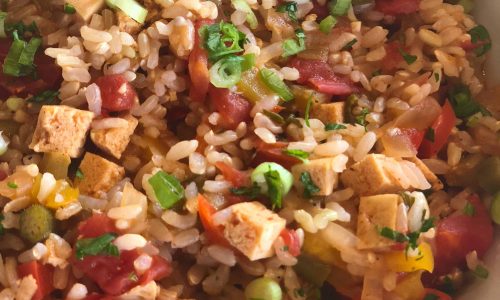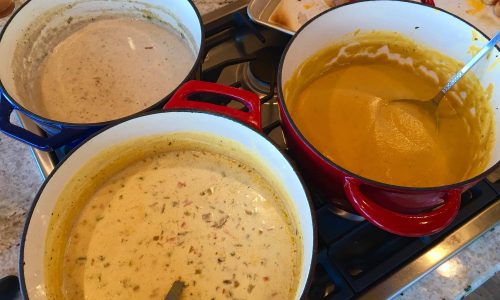Going back to school after a month long break was rather hectic, to say the least. My class in from 5:30-10:30 on a week night now. I get up at 5:30, work 7:30-4:00, then head off to culinary school. For the first couple weeks we are studying “Garde Manger”. Literally it means, “keeper of the food” but more commonly today it means the taks of preparing and presenting cold foods. Think salads, hors d’oeuvres, cold soups, aspics, and charcuterie. We learned that the flavor of food diminishes when it is served cold so we will have to pay close attention to the seasonings and actually taste the food at the serving temperature, not just the temperature at which it is prepared. The lecture by Chef Kurima detailed the various elements of garde manger and she showed slides of various salads and sandwiches. I now know the difference between a composed salad, tossed salad, and side salad. We also drew the names of countries and regions we would be studying in the coming weeks, drawing names we would be responsible for presenting. I drew Northern Italy, Austria, Singapore, Connecticut, and Louisiana. Singapore isn’t so bad. I actually prepared Singapore Chicken and Rice recently after seeing an Anthony Bourdain episode on it. Italy is easy, Austria not too bad, and Louisiana is a cinch, but Connecticut??? What do they eat there? I don’t have a clue.
For the night’s assignment we were divided into groups of 3 and given a list of dishes to prepare:
Plated Salad Nicoise, Plated Caesar Salad, Plated Reuben Sandwich with side, Plated Club Sandwich with Side, and each group made one of the following: Croque Monsieur, Croque Madame, Monte Cristo, Monte Cristo, Madame variation.
Does this sound like a lot of food to prepare in 2 hours and 45 minutes? Oh, I almost forgot, we also had to prepare our own choice of either sandwich and side or salad.
Somehow we managed to make the food by assigning things to one another we could share as a group. Only one person made the required homemade mayonnaise for all and only one person made the Caesar dressing for all. Still, it was hard to get it all done and we were also out of practice. I felt the kind of panicky, anxious feeling I got last semester for a while. I felt good about the dishes I prepared at the end, though. I made a decent Caesar salad, although I plated it on too small a plate (I should have learned last semester not to let the other students pick out the plates for the group.) I made the homemade potato chips which were OK, not quite crisp enough, but looked nice, and I helped with the Monte Cristo sandwich. My own creation was an herb-egg salad sandwich. I rushed to get it done in time and it was pretty tasty. I am including my favorite recipe of the night, Monte Cristo sandwich:
Makes 2 sandwiches
4 slices bread (white works good)
1/2 oz Dijon mustard
2 slices Gruyere cheese
2 slices ham
2 slices Muenster cheese
soft butter
Spread bread with mustard, layer with slice of Gruyere, ham, and Muenster cheese. Dip the sandwich in beaten eggs and grill in melted butter as you would french toast.
Cut into quarters on the diagnonal and sprinkle with powdered sugar. Melt some raspberry jelly and dip pieces of the sandwich into the jam. Delicious!
On another note, I am including a family recipe I sent to the Star Telegram for an article they are writing called, “Family Ties”. They asked for family recipes passed down from generation to generation. In honor of my mother, Tommie Steele, I wrote the following:
Sukiyaki
My mother, Tommie Steele (Tamiko Abe before she married) was from Tokyo, Japan. She came to the United States in 1953 with my father, an American GI. American food in the 50’s was hard to like for my mother who grew up with the freshest fish, vegetables and fruits. My father, Zack Steele, was from Hickory, North Carolina, so my mother’s first exposure to food was fried chicken, vegetables cooked in bacon grease and bread instead of rice. She longed for a bowl of rice. My grandmother made her rice one day and my mother was so excited. The rice was covered with sugar, butter, and milk which made my mother want to cry. My first recollection of Japanese food is the special sukiyaki dinners prepared by my mother. These were special events since the sukiyaki was prepared at the table while we all watched and helped. In Japan, sukiyaki is a family style meal in which meat and vegetables are cooked in a simmering sauce at the table. Each person is given a bowl with beaten, seasoned egg to use as a dipping/cooling sauce as they pick out hot pieces of meat or vegetables from the pan. We always used an electric skillet. When guests came over they were always impressed with the delicious and different meal. I spent four years in Japan in the Air Force and was able to meet my Japanese grandmother, aunt, and cousins for the first time. They cooked a sukiyaki dinner for me one night and it was just like my mother’s! The only difference was the beef cost $40.00 a pound and that was in 1978. I started making sukiyaki for my family when I returned from Japan in 1980 and have been making it ever since. I never thought much about passing it on to my four children until a few years ago when my oldest daughter, Helen Olin, (who happens to be the News Editor at the Houston Chronicle) called me and asked for the recipe. She made it for her family, then friends, and is now known for her special sukiyaki dinners. My granddaughter Grace, when asked what her favorite food was in kindergarten, replied, “sukiyaki” Grace has blond hair and blue eyes and looks nothing like her Japanese obachan (great grandmother) but she loves all things Japanese. I believe Grace will be the next generation cooking sukiyaki just like my grandmother and mother made it for me.
Sukiyaki
Sauce
½ cup soy sauce
½ cup sugar
1 cup water
2 T Mirin
Mix ingredients together and put into a small glass pitcher to be brought to the table.
1 ½ lbs thinly sliced beef (I use rib-eye steak, frozen then sliced very thin)
1 T vegetable oil
1 bunch green onions or 1 large white onion (or both)
1 14 oz block fresh tofu (medium firm)
12 oz. shirataki (remove from package and boil briefly, rinse, and drain)
1 16 oz. can bamboo shoots, sliced
8 oz. fresh shiitake mushrooms, sliced
Udon noodles (pre boiled to loosen)
4 cups napa cabbage, chopped
Japanese rice, cooked
Place electric skillet or large pan on butane burner in center of table. Give each diner a plate, bowl of rice, a small bowl of pasteurized egg product sprinkled with togarashi (7 spice chili powder) Put oil in hot skillet. Add beef and cook until slightly done, just a minute or two. Put beef in a corner of the skillet and add the other ingredients, keeping them in their separate areas. DO NOT MIX EVERYTHING TOGETHER. Add sauce, enough to barely cover the ingredients and cook for four or five minutes. As things become ready diners use chopsticks to pick out what they like, dipping the items in the egg to cool. Although it’s not the Japanese style, Americans like to spoon sauce from the pan over their rice.
As the pan empties, add more meat, vegetables, sauce.



